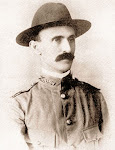
The Third Nebraska Volunteer Infantry served as part of the occupation force in Cuba following the Spanish American War. The Third Nebraska originally was intended to serve in Cuba as part of Major General William Shafter’s Fifth Corps. However, the unit served as part of Fitzhugh Lee’s Seventh Corps instead. The Third Nebraska was raised in the second call for volunteers, and was mustered into service between July 1 and July 17, 1899 at Omaha, Nebraska. At the time of mustering in, the unit consisted of forty offices and 1,274 enlisted men. The colonel of the regiment was none other than William Jennings Bryan, who had run against William McKinley for the presidency.
The Third Nebraska was not involved in any of the major battles but would have faced the dangers of illness and disease, serving in camp in the U.S. and as part of the occupation force in Cuba. The unit was encamped at Camp Cuba Libre in Jacksonville, Florida while the war was ongoing. The fighting ended less than a month after the Third was mustered into service, when an armistice was set in place on August 12, 1898.
The Third Nebraska departed for Cuba on December 30, 1898, twenty days after the Treaty of Paris was signed, ending the war. The unit arrived in Cuba on New Years Day, 1899. The Third Nebraska served in Cuba until April 7, 1899, arriving back in the U.S. five days later.
The Third Nebraska Volunteer Infantry was mustered out of service on May 11, 1899 at Augusta, Georgia. At the time of mustering out, the unit consisted of fifty-five offices and 1,251 enlisted men. During its term of service the unit had one officer and thirty-one enlisted men die of disease. In addition, twenty men were discharged on disability, one man was court-martialed and three men deserted.
This regimental history is courtesy of the Spanish American War Centennial Website which you can visit at www.spanamwar.com.


 This past weekend I visited a local monument to the veterans of the Spanish American War here in Omaha, Nebraska. The monument and two period cannons are on display near the front gate at Westlawn-Hillcrest Cemetery located at 57th and Center Street. The monument is an impressive granite marker with some rather elaborate engraved details and an attached brass plaque. The two cannons are actually reproductions constructed by students from a local high school. There were also several grave markers for Spanish American War veterans, but I will have to go back in the spring because too many of them were covered with ice and snow. Overall it is an impressive memorial to the veterans of a bygone era and a forgotten war.
This past weekend I visited a local monument to the veterans of the Spanish American War here in Omaha, Nebraska. The monument and two period cannons are on display near the front gate at Westlawn-Hillcrest Cemetery located at 57th and Center Street. The monument is an impressive granite marker with some rather elaborate engraved details and an attached brass plaque. The two cannons are actually reproductions constructed by students from a local high school. There were also several grave markers for Spanish American War veterans, but I will have to go back in the spring because too many of them were covered with ice and snow. Overall it is an impressive memorial to the veterans of a bygone era and a forgotten war.



